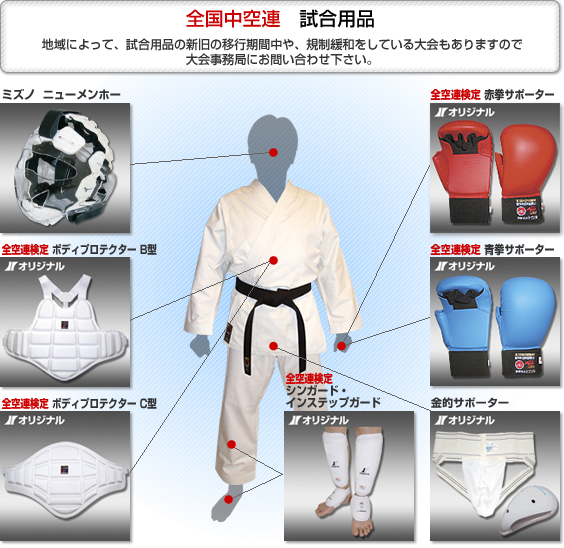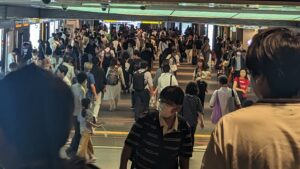
Return to Japan 2023 Week TWO
All Gojuryu Network (www.gojuryu.network) & SKSV (Gojuryu.net) cross-post
By Johnpaul Williams – August 21, 2023
Continued from Return to Japan 2023 Week ONE
August 16th, 2023 – Wednesday: Travel and Rest. Today marked a travel and rest day, although I use the term “rest” loosely. After a final breakfast at the hotel canteen, we boarded the Shinkansen to Tōkyō 東京 at 09:50 am. Despite Ōmagari 大曲市 Daisen 大仙市 being a small town with its own Shinkansen station, the train was packed. The typhoon crossing Japan from Southeast to West was causing travel disruptions, and we heard that bullet trains from Tōkyō 東京 to Ōsaka 大阪 were delayed by up to 4 hours due to the rain.
Upon arriving in Tōkyō 東京, the station was in near chaos, with thousands of people standing in various lines and darting in and out of openings, hoping to catch their trains. As we made our way to the gate leading to our track, we encountered fellow Seiwakai international members. Some were heading to Narita Airport to fly back to their home countries, while others were making the journey to Ōsaka 大阪 for the JKF Gōjūkai Taikai.
Now, some 14 hours later, we have arrived at our hotel in Ōsaka Nanba 大阪難波. There isn’t much to report except for several shirts that need rinsing (does that count as a dad pun?). I’ve definitely shed a few pounds hauling baggage around Tōkyō station 東京駅 and Japan in general. Our detour to avoid the weakening typhoon took us north through Kanazawa, where we connected with another train heading southwest to Ōsaka 大阪. Some of our Canadian friends did something similar using a different set of trains and arrived approximately 1.5 hours after us. If we had waited at Tōkyō station 東京駅, we were told we would have arrived only 4 hours late, as initially thought, because the trains were eventually put back on a delayed schedule.
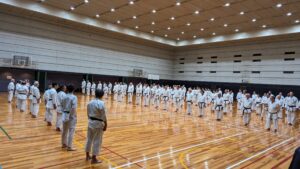
2023 JKF Gojukai Kokusai Gasshuku opening ceremony
August 17th, 2023 – Thursday: Day 9 – Variable Training Intensity. Today marked another day of the JKF Gōjūkai Kokusai Keiko or International JKF Gōjūkai training. This event is known for being somewhat less physically demanding in comparison to the Seiwakai Gasshuku in Ōmagari 大曲市 Daisen 大仙市. However, it compensates with a significant focus on precision and both performance and applicable (bunkai) kata details. Many of the details are new and presented differently than in previous years and most of these “different,” details aren’t considered “kata changes.” Either way, I’ll diligently record these modifications in my Kata Logbook, as I do every year.
My special observation is that many visiting members of the JKF Gōjūkai (regardless of their club or dojo) come to Japan approximately a week before training to prepare with their honbu (headquarter) dojo and head Sensei in preparation for the upcoming grading. Today’s group iss no different with many familiar faces and many new faces all having the same goal in mind, too pass.
I can’t help but notice the swelling in my leg as I limp along through kata and on the walks back and forth to the arena. I began to wonder whether I should sit out tomorrow’s two-hour training session and potentially the competition on Saturday. As my thoughts gather I refer back to lectures by Tasaki Shūji 田崎修司, a specific moment in particular of he having said to a participant showing their struggles on the outside “Naze Nihon ni kuru nodesu ka? Anata wa junbi ga totonotte inai. Anata wa kega o shite imasu?” (why would you come to Japan if you are not prepared or / and injured.)
In the afternoon, we regrouped, and those who were in Japan specifically to grade were asked to train at the front of the room. This is a common practice each year, and everyone must adjust based on their grade and their relationship with the instructors present.
August 18th, 2023 – Friday: Day 10 – Battling Swelling. Today has been what I’d like to call “Swollen Leg and Knee Day.” Normally, the circumference around my knee is approximately 16.5 inches. However, this morning, I was in for a surprise. My right knee measured a whopping 18.5 inches in circumference, while my left knee was just under 17 inches. Fortunately, our hotel is conveniently located about 1.5 blocks away from the training venue. I decided to take it easy today, considering it’s only a 2-hour session before we again separate. I have intentions to train at the rear of the group, out of the way of others who were preparing for their tests. Maybe I’d even find a moment or two to train alongside some old friends and colleagues I hadn’t had a chance to catch up with yet. After all, that’s what a gasshuku is all about – training and lodging together to build a sense of camaraderie. Luckily I had the pleasure to get a few tips from Mark Posselius.
At this point everyone attending the JKF Gōjūkai gasshuku (seminar) are again divided. Those who are grading are sent to another room to continue their workout independently and make final preparations if necessary. The rest of us not attempting the JKF Gōjūkai shinsa this year remain
Upon completing the training and closing ceremony, I was eager to hear the results of all those involved in the grading. Generally, most attempting the the grades of first to fifth dan (degrees black belt) pass with relative ease and only a few exceptions. They pass because they wouldn’t have been invited by their instructors back home if they weren’t well-prepared. However, for those attempting the sixth dan or higher grades, it’s a different story. This group faces a much higher failure rate, as they are held to a higher caliber and are expected to be the future instructors and thus the stricter standards by comparison to those attempting the lower-degree grades. I hoped that my friends and colleagues would perform well. Seiwakai has always been strong, and we have a lasting reputation to uphold.
Post-Training Activities and International Board Meeting. After the rigorous training sessions concluded, there was various paperwork that needed to be completed to meet compliance and certification requirements, including dojo registrations. In previous years, Seiwakai clubs in the USA were registered under the umbrella names of Seiwakai East, Seiwakai West, and Seiwakai Central. However, this year, the list read differently, with names like Seiwakai New Mexico, Seiwakai Great Lakes, and Seiwakai of LA. With permission from Vassie Naidoo Shihan, I took the opportunity to register SILICON VALLEY GŌJŪKAN (シリコンバレー剛柔館) with the Japan Karate-Dō Federation Gōjūkai [JKF Gōjūkai ; 全日本 空手道 連盟 剛柔会] to represent our club, SEIWAKAI KARATE SILICON VALLEY. Our commonly known name, representing SKSV, simply wouldn’t fit on the paper, so this will serve as our “doing business as” (DBA) name for our JKF registration. This registration has been long overdue and will be required for our future endeavors as I step up our clubs presence.
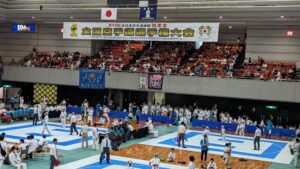
2023 the 29th JKF Gōjūkai taikai and shiai in Ōsaka 大阪
Those who are preparing for the examination will remain on the premises while everyone else is dismissed. Some of us also stay for the international board meeting, where I once again had the honor of accompanying Vassie Naidoo Shihan. The meeting is led by Fujiwara Seiichi Shihan and co-chaired by Takugawa Shihan, with assistance from Nakano Mieko Shihan.
During this meeting, directors from each country report on their experiences and growth, as well as the challenges they faced during the COVID-19 shutdown and how they persevered. As the meeting progressed, I had the opportunity to present two new items for the agenda:
- The creation of a JKF Gōjūkai women’s division (Joshi-bu).
- The implementation of web-based and electronic registration for seminars, tournaments, and associated events.
- Note: I intend to create a mockup similar to this for Seiwakai 2024, which I will present before or during the meeting in November.
Other topics brought up during the meeting included, but were not limited to:
- Vassie Naidoo Shihan’s proposed the use of an English version of the JKF Gōjūkai membership card and application.
- The need for better and more frequent updates on the JKF Gōjūkai website.
- An earlier release of dates for future events, including the 50th tournament in Okinawa in 2024,
- Note: At this point we discovered that some attendees were already aware of the dates, being August 15 – 18, 2024.
- The establishment of a JKF Gōjūkai Kumite committee, similar to the existing Kata committee.
- A request (from the New Zealand representative) for non-Japan members to be included in the overseas committee.
The meeting served as a platform for valuable discussions and the exchange of ideas to further enhance our karate community on an international scale.
August 19th, 2023 – Saturday: Day 11 – The Day of Competition. Today is the day we’ve all been waiting for – Competition Day. The venue this year far differs from the familiar “Big Whale” arena also in Ōsaka 大阪, and there won’t be a formal march onto the competition floor, unlike other JKF Gōjūkai shiai (competitions) in the past. However, just like in life, there’s always room for reasonable adaptations.
As the day unfolds and the competition gets underway, the atmosphere crackles with excitement. Emotions are running high, and the jitters spill over, creating a spectrum of feelings from intense focus to tears of anticipation to agony of defeat. It’s a rollercoaster of sensations as we prepare to give our all on the tatami.
Mentoring for Success in a Foreign Arena. Over the years, I’ve had the privilege of mentoring many individuals on how to represent themselves effectively and what to anticipate in events such as the grading and competition during this excursion, especially when it’s on foreign soil. I’d like to reiterate these points here for the benefit of all.
First and foremost, we shouldn’t come expecting glory; instead, anticipate the invaluable experience. Remember, we’re in Japan, and this isn’t our home turf. Whatever reputation or status we might hold in our own country or home-town may not necessarily carry the same weight here. We must assimilate into the local culture, displaying the level of respect expected and demonstrate humility in the face of defeat, regardless of our personal opinions or past achievements. This is essential when competing on an international stage such as the JKF Gōjūkai Taikai.
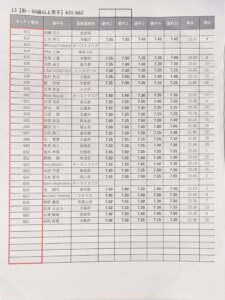
JKF Gojukai men’s senior Kata results
Adapting to Challenges on the Tatami. In my case, returning to this familiar setting has left me as relaxed as ever. However, with my knee and leg swollen, filled with synovial fluid, effective and efficient kicking is a challenge beyond reach. Rather than seeking pity or making excuses, I’m presented with a choice. I must either select a kata with minimal kicking and bear the pain with gaman (我慢) – the Japanese spirit of endurance – or opt for a kata with no kicks at all. Hence, I decided on Seiyunchin Kata (形制引鎮).
Following my time on the tatami, I must admit I’m content with my performance in the competition. I managed to execute my kata despite the considerable swelling, all while adhering to the principles of relaxation and competitive spirit. Doing some quick mental calculations, I initially believed I had secured the 12th position out of 32 competitors. However, I was pleasantly surprised to learn from Nick Naudy (who happened to be in my father’s division) that I had actually secured the 9th spot. I had missed a top 8 award by a mere 5/100 of a point. Next year, I’ll return to the challenge with renewed determination, giving it my absolute best.
Shin / Instep protector optional and head protector’s mandatory??? WHAT???
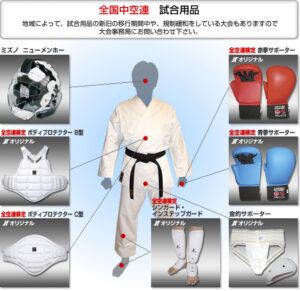
Required JKF kumite gear as of 2022
This year brought a somewhat new experience, and although I should have attended the coaches’ meeting last year, an unfortunate mishap led to the loss of our USA team coach’s ID. Here’s a quick summary: the World Karate Federation (WKF) mandates the use of head protectors for participants under the age of 14, and as I glanced around, it became evident that every division, without exception, adhered to this requirement.
However, a twist of fate awaited one of our Seiwakai competitors. Fully prepared for the kumite division with red and blue gloves and belts, they had overlooked the essential head protector, not to mention lacking both colors or white-only instep/shin protectors. Fortunately, my years of building and maintaining relationships with many athletes-turned-coaches and Sensei came to the rescue. I swiftly sourced a medium-sized Mizuno karate head protector, ensuring our athlete could participate safely.
But the challenges didn’t end there. I had to make a quick pit stop at the referee’s table to engage in a discussion about the mandatory foot protectors. It became apparent that three different mats had ongoing matches, with at least one competitor on each mat lacking any foot protection at all. I advocated for their safety and managed to rectify the situation.
All of this unfolded while I grappled with a significant limp, yet I made it back to our athlete’s ring just in time for her match, as if propelled by the swiftness of a NIKE swoosh.

Karate head protector by Mizuno
Navigating Equipment Challenges. In our club, I often recommend that team members invest in competition gloves and belts in both red and blue, keeping them readily available in their bogu bags. However, when it comes to shin/instep protectors, I typically advise acquiring “white” to reduce the overall cost of participation and the bulk in their bags. Unfortunately, our Seiwakai competitor arrived with a single-colored version of foot gear. After some swift translation and arbitration, we determined that shin/instep pads were optional. However, it became apparent that head protectors were now mandatory and not readily available in the USA so we made arrangements to borrow a headset from my friends, sons, college classmate who had completed all of his competition eliminations for the day.
As a result, I’ve sourced two vendors from Japan and I’m placing an order for several head protectors for our club upon my return home. This will serve the dual purpose of ensuring our members’ safety and preparing them for elite WKF divisions, especially if they are under the age of 14 or plan to train and compete in Japan.
Our Seiwakai USA athlete didn’t win the opening match, which meant she didn’t progress to the next round. Nevertheless, I’m immensely proud of her for seeking out this level of competitive exposure. The “experience” may take some time to fully sink in, but she’ll come to appreciate the lesson it offers. After reviewing video, revising tactics, applying additional relaxation, and perfecting timing, she’ll approach the next competition with an even more composed demeanor. I’m confident that her improvement will bring many more top earnings in the future.
After the match, I took a moment to wait for the referees and express my gratitude for their patience. I also accepted my reprimand and offered my apologies for not being in proper attire while on the tatami. Our coaches’ badge had gone missing, and I had to borrow one from another team at the last minute before addressing the unfolding events on the floor. I’ve been scolded before, and I’m comfortable with my position, so extending apologies on behalf of our group was expected.
A Memorable Evening with the Sato Family. Tonight, we were treated to a truly heartwarming welcome by my longtime friend, Sato Masaki, his wonderful wife, and their remarkable sons. Both of their sons have displayed spectacular prowess in kumite, just like their father and uncle Yuki (whom I’m looking forward to seeing tomorrow). It’s worth noting that both young talents are featured in this month’s edition of JKFan Magazine, a well-deserved recognition of their skills.
With a hint of bashfulness, I mustered the courage to request their autographs on the pages of JKFan magazine which they appeared in, and to my delight, they graciously agreed. It was a special moment as it marked the first time they had ever autographed anything. This evening was a perfect blend of camaraderie, admiration, and shared pride in the achievements.
August 20th, 2023 – Sunday: Day 12 – The Sato Family Reunion. What an incredible day it has been spent with the Sato family – a warm, wonderful, and close-knit clan. Today, we had the pleasure of also being reacquainted with Sato Yuki, the older brother of Sato Masaki, who came to the shiai (competition) to greet us. Of course, Sato Masaki and his son, Sato Yuji, were also present. After the intense competition finals, we made plans to head out for some delicious ramen and then conquer the Ōsaka 大阪 Tsūtenkaku (通天閣) Tower.
One intriguing feature of the tower is a rather terrifying slide that descends from the top. We contemplated giving it a try, but I couldn’t help but wonder if my towering 190 cm and 105 kg frame might end up getting stuck halfway down!
The view over Ōsaka 大阪 from the Tsūtenkaku (通天閣) Tower is nothing short of breathtaking. At its peak, it soars over 100 meters high, and we ventured all the way up to the outer upper-level observation decks, which are thoughtfully enclosed with fences to prevent tourists from being blown away by the strong winds.
As the afternoon passed quickly, we were reminded that tomorrow is our travel day back to the United States. There’s also the pressing matter of tackling the laundry backlog from the past few days. Sato Masaki and I wrapped up the evening discussing future plans for his sons’ training under SKSV, our upcoming meeting next summer in Okinawa, and our continued collaboration in San Francisco/Silicon Valley. We part ways having built a stronger bond, having laid the foundation for many years of shared adventures in the future.
August 21st, 2023 – The Road Home: Day 13. Today marks our journey back home, with a departure scheduled for 5:55 pm. However, there’s a peculiar time warp awaiting us; we’ll land in California just after noon on the same Monday. Despite Shiho not feeling well, we’re determined to meet with a few of our former club students from our Menlo Park dojo who have relocated back to Japan. ‘Yu’ and her younger brother ‘Ori’ will be waiting for us at Narita Airport, where we’ll arrive via the Narita Express.
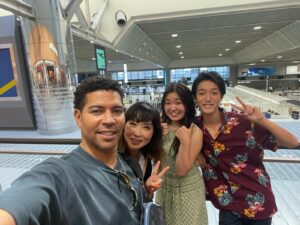
Johnpaul and Shiho with Yu and Ori at Narita airport
Even before the train comes to a halt and the doors swing open, I can spot Ori’s head rising above the crowd of the other native Japanese waiting to board the train as we arrive. He’s grown significantly, and I can’t help but feel a sense of pride. Ori has transformed into a handsome young man with a chiseled chin and a stylish haircut. Yu, to my surprise, still possesses her infectious laughter and wonderful personality. She’s diligently working on college applications, which are due for submission this fall, and I’m keeping my fingers crossed for her. Both of them are exceptionally bright and ambitious, with aspirations of returning to the United States for university studies, particularly in the prestigious Ivy League educational system. These two youngsters, willing sheer determination, just might make it happen!
Now, as we settle into our seats on board our Japan Airlines flight, I have Wi-Fi access (naturally), and I’ll upload this revised blog post. When we eventually touch down and make our way home, there should be enough time to unpack, rest, rehydrate, and still make it to Menlo Park for tonight’s training session. I’ve got a notebook filled with kata revisions to introduce into the club’s curriculum, making it an exciting evening ahead.
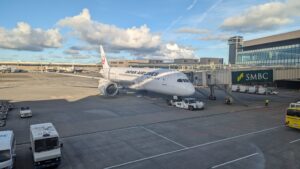
The obligatory airplane photo
Johnpaul Williams
August 21-23, 2023: A Challenging Return Stateside
We’ve touched down back in the United States, but our journey has taken an unexpected turn. Unfortunately, there won’t be any training tonight. Shiho is feeling unwell, and just a short while ago, she received the results of a COVID test – it’s positive. I’ll be crafting a new blog post shortly, once we’re back at home. It’s a tough situation, as this likely means I’ve been exposed as well.
Update to the Update: A Surprising Turn of Events
Upon our return home, it’s become evident that COVID has made its way into our lives. We’ve assessed the timeline of symptoms and contagiousness, and it seems that our exposure most likely occurred while we were stranded at Tōkyō station 東京駅. It’s a sobering realization. I distinctly recall making a casual joke out loud at one point, saying, “I hope I don’t catch the corona from this crowd.” Little did I know how prophetic those words would turn out to be.
Johnpaul Williams

